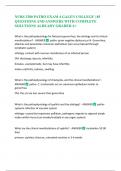NURS 3280 PATHO EXAM 4 GALEN COLLEGE | 85
QUESTIONS AND ANSWERS WITH COMPLETE
SOLUTIONS ALREADY GRADED A+
What is the pathophysiology for Neisseria gonorrhea, the etiology and its clinical
manifestations? - ANSWER patho- gram negative diplococcus N. Gonorrhea,
attaches and penetrates columnar epithelium (can occur/spread through
lymphatic system)
etiology- contact with mucous membranes of an infected person
CM- discharge, dysuria, infertility
females- asymptomatic, but may have infertility
males-urethritis, redness, swelling
What is the pathophysiology of chlamydia, and the clinical manifestations? -
ANSWER patho- C. trachomatis act on columnar epithelium similar to
gonorrhea
CM- the s/s are less severe than gonorrhea
What is the pathophysiology of syphilis and the etiology? - ANSWER patho-
systemic infection of vascular system
etiology- caused by treponema pallidum, pathogens migrate to regional lymph
nodes within hours (can invade/multiply in any organ system)
What are the clinical manifestations of syphilis? - ANSWER Incubation 10-90
days
primary- painless chancre, untreated resolves in 3-6 weeks
,secondar- untreated chancre resolve, followed by cutaneous rash, flu like s/s
(spread throughout bloodstream and lymphatic system)
latent- no s/s present early latent= contagious, last up to 40years
tertiary- cardiovascular and nervous system at risk, aortic necrosis and
insufficiency (damage to CNS paresis, blindness, mental deterioration)
what is the pathophysiology of genital herpes, its etiology, and clinical
manifestations? - ANSWER patho- virus in ganglion neurons
etiology- self-limiting, virus stored in ganglion neurons, stress=trigger activation
CM- fluid field vesicles after 3-7 days incubation, lesions recut at the site of initial
occurrence
females= cervix
males= glans penis, foreskin, shaft
what is the pathophysiology of HPV, and the etiology? - ANSWER patho-
epithelial lesions of anogenital region, infests single epithelial cells- divides and
proliferates
(incubation 1-20months)
etiology- epithelial lesions- geneital warts
what is the clinical manifestations for HPV? - ANSWER Period of
communicability unknown, thought to last as long as lesions persist and possibly
even after removal, single or multiple lesions, soft pink to brown, small-large,
raised or flat, pruritic, painful, bleed easily
Females- vagina and cervix, anogenital area
(cervical cancer with some types of warts)
males- urethra, anogenital area
, What is the pathophysiology epididymitis, etiology and clinical manifestations? -
ANSWER patho- bacterial cause with STDs, C. trachomatis, E.coli
etiology- inflammation of testes
CM- enlarged scrotum, red, tender, fever, pain along spermatic cord
What is the pathophysiology of Fournier gangrene, the etiology and clinical
manifestations ? - ANSWER patho- gangrenous necrosis of scrotum
etiology- alcoholism, DM, perforated urethral diverticulum, non-urinary tract
source= perirectal abscess, extravasation of infected urine from urethral trauma
CM- s/s shock (high fever, decreased BP, decreased HR) sepsis, pain, swollen
genitalia
what is pathophysiology of benign prostatic hyperplasia, the etiology, and clinical
manifestations ? - ANSWER patho- hyperplasia of glands, compression of
urethra, changes in endocrine system
etiology-unknown, BPH does not predispose pt to prostate cancer
cm- s/s of obstruction, decreased urine stream, forceful, hesitancy, difficulty
starting stream, interruption of stream, increased risk for uti due to retention
what is the pathophysiology of prostatitis, etiology and the clinical manifestations
? - ANSWER patho- inflammation of prostate
etiology- bacterial prostatitis= E. coli
CM- Acute= fever, chills, low back pain, dysuria
Chronic- voiding symptoms, localized pain, harder to treat




